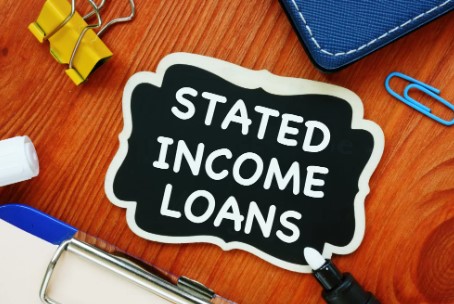Stated Income Loans: A Convenient Alternative for Self-Employed Borrowers

Introduction: What Happened to Stated Income Loans?
Stated-income loans have made a cautious return, with more stringent requirements aimed at protecting both lenders and borrowers. This modern iteration offers a convenient alternative for self-employed individuals who may struggle to meet traditional mortgage criteria. In this article, we will explore the details of the modern stated income loan and how it can benefit specific types of borrowers.
What Is a Stated Income Loan?
A stated income loan allows borrowers to “state” their income without providing formal documentation like tax returns or pay stubs. Instead of requiring proof of income, lenders rely on the borrower’s stated earnings and other assets to assess their ability to repay the loan. This flexibility can be particularly beneficial for those with non-traditional income sources or self-employed individuals whose income may not always be consistent.
Historically, these loans were popular among self-employed individuals, freelancers, and real estate investors who might not fit into the conventional income verification model. While the concept remains appealing, the implementation of stated income loans has evolved significantly since the housing crisis. Today’s stated income loans are designed to ensure that borrowers are genuinely capable of repaying their loans, providing a balance between convenience and financial responsibility.
Read also: The Secrets to Lightning-Fast Loan Approvals That Banks Hope You Never Discover
How Do Stated Income Loans Work Today?
Stated income loans in today’s market are far more regulated than they were before the financial crisis. Lenders have established stricter criteria to ensure that borrowers can manage their loans responsibly. To qualify for a stated income loan, borrowers now typically need to meet the following requirements:
- Excellent Credit Scores: Lenders look for borrowers with high credit scores, often requiring a minimum score of 680 or higher. A solid credit history demonstrates the borrower’s reliability and capability to repay debts.
- Significant Down Payments: While traditional loans may require down payments as low as 3%, stated income loans generally necessitate larger down payments—often at least 20% or more. This requirement reduces the lender’s risk and demonstrates the borrower’s commitment to the investment.
- Extensive Assets: Borrowers must provide evidence of substantial assets, such as savings accounts, investments, or property equity. This serves as a cushion for lenders, assuring them that the borrower has resources to draw upon if needed.
- Income Verification Through Alternative Means: While tax returns may not be required, lenders may ask for other forms of verification, such as bank statements or profit and loss statements, to get a clearer picture of the borrower’s financial situation.
These enhanced requirements help ensure that stated income loans are granted to borrowers who have the means to repay them, addressing some of the issues that led to the collapse of the housing market in the past.
Who Can Benefit from Stated Income Loans?
Stated income loans can be particularly advantageous for several types of borrowers:
- Self-Employed Borrowers: Self-employed individuals often face challenges when applying for traditional loans due to irregular income patterns. They may not have consistent records of earnings or may have deductions that significantly lower their reported income. Stated income loans allow these borrowers to demonstrate their ability to repay through alternative means, making homeownership more accessible.
- Real Estate Investors: Investors with multiple properties and fluctuating income may also use stated income loans to finance new investments. The ability to leverage assets rather than relying solely on income documentation can enable investors to expand their portfolios more easily.
- Business Owners with Complex Finances: Business owners, especially those in industries with variable income, can benefit from stated income loans. These individuals often prefer to use gross income rather than net income, especially when tax deductions significantly reduce their taxable income. This option allows them to qualify for loans without being penalized for legitimate business expenses.
Benefits of Stated Income Loans
The advantages of stated income loans can make them an attractive option for self-employed borrowers and others with unique financial situations:
- Simplified Documentation: The reduced need for extensive documentation can make the loan application process faster and more straightforward. This is especially beneficial for borrowers with complex income streams, as they can focus on stating their earnings rather than compiling extensive paperwork.
- Greater Flexibility: Stated income loans offer an option for borrowers who can’t qualify through traditional means. This flexibility is crucial for those with complex or fluctuating income, allowing them to secure financing without the constraints of conventional income verification.
- Access to Financing: For many self-employed individuals and business owners, traditional financing options may be limited or unattainable. Stated income loans can provide a pathway to financing that enables these individuals to pursue their goals, whether that be purchasing a home, refinancing an existing loan, or investing in additional properties.
Drawbacks of Stated Income Loans
While stated income loans present several benefits, they also come with certain drawbacks that borrowers should carefully consider:
- Higher Risk and Interest Rates: Due to the minimal documentation required, these loans often come with higher interest rates compared to conventional loans. Lenders view these loans as higher risk, which is reflected in the cost of borrowing.
- Larger Down Payment Required: Borrowers usually need to make a more substantial down payment, often at least 20%. This requirement can pose a barrier for some borrowers who may not have enough savings to meet this threshold.
- Stricter Credit Requirements: To qualify for a stated income loan, borrowers must have excellent credit. This requirement can limit access for those with less-than-perfect credit histories, even if they have substantial assets or income potential.
- Potential for Misrepresentation: With less documentation required, there is a risk that some borrowers may overstate their income or assets. Lenders must balance the need for flexibility with the responsibility of ensuring that borrowers can repay their loans.
Conclusion: Is a Stated Income Loan Right for You?
Stated income loans offer a convenient financing option for self-employed borrowers and those with non-traditional income sources. However, they come with significant requirements and considerations. If you have a high credit score and can provide substantial assets, stated-income loans may be a viable alternative, especially for those who find traditional mortgage processes challenging. As with any financial decision, it’s crucial to weigh the benefits against the drawbacks and consult with a knowledgeable mortgage professional to determine if this option aligns with your financial goals. By understanding the nuances of stated income loans, you can make an informed decision that supports your path to homeownership or investment success.




